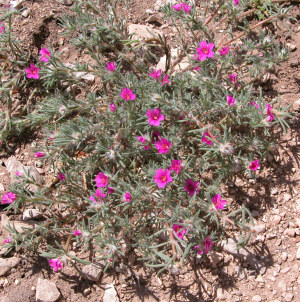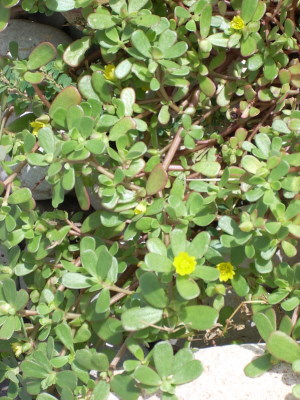Purlsane, Verdolaga
Portulaca oleracea L.; Portuluaca mundula I. M. Johnston
Portulcaceae (Purslane Family)
Purslane is a small, prostrate fleshy or succulent annual herb widely used for food; it also had medicinal uses. The branches spread along the ground radially from the central root (Correll and Johnston 1970). Once thought to be introduced, purslane is now known to be a native plant with cosmopolitan distribution (Byrne and McAndrews 1975). The plant can germinate throughout the growing season, which can last over 300 days in southern Texas/northern Mexico. This makes purslane a valuable source of fresh greens throughout the growing season, because greens are consumed while the plants are only a few weeks old.
Archeological Occurrence. Purslane seeds are commonly recovered from archeological sites throughout the greater Southwest and western Texas (Dering 2001; 2006; Dering et al. 2000; Holloway 2005). Purslane has yet to be identified from rockshelters in the Lower Pecos region, most likely because the earliest studies were conducted on screened samples (Irving 1966) and later studies were conducted on small samples from a single location (Dering 1979; 1999). The seeds of purslane measure no more than 1-mm and only unscreened samples of rockshelter deposits will be able to detect its presence.
Food. Purslane, or verdolaga, greens are consumed as a vegetable and the seeds are ground into meal or flour (Hodgson 2001). The Tarahumara collected and consumed several different types of greens including goosefoot, pigweed, mustard, peppergrass, in addition to verdolaga. The greens were gathered during a point in the growth cycle when the nutrients in the plants peaked (Bye 1981). Verdolaga contains an abundance of Vitamins A and C. A short list of Southwestern groups that were observed to collect members of this versatile genus includes the Laguna, the Isleta and other Pueblo groups, the Navajo, the Ramah Navajo, the Tewa, the Chiricahua/Mescalero Apache, Pima, and the Tarahumara, (Castetter 1935; Castetter and Opler 1936; Pennington 1963; Vestal 1952).
In an interesting twist (since one thinks of greens as being consumed fresh) some groups dried the greens for storage and reconstituted them for winter use (Jones 1931; Pennington 1963). Whether fresh or reconstituted, the greens were used as a pot herb and added to stews and soups, or cooked with onions, tomatoes, and chiles (Castetter 1935). Verdolaga is continues to be collected or cultivated in small kitchen gardens today in Mexico (Bye 1980; Weiss 1994). One Tipai Cochimi said that it made him "strong". At any rate, one method of preparation is to boil the greens for 15 minutes with onions, tomatoes and chicharrones. Even when sautéed, verdolaga is apparently boiled first. (Weiss 1994).
The seeds also were consumed, by the hundreds of thousands. Mature plants were plucked from the ground and the tiny seeds were dislodged by beating into tighly woven baskets. The Pima gathered large quantities of seeds and ground them into flour (Russell 1908). The Zuni gathered the entire plant before the fruits ejected the seeds, stacked the plants on large mats, and waited for the seeds to drop (Cushing 1974).
Medicine. The healing power of Portulaca comes from its ability to contract wounds, likely a property of the gelatinous hydrocolloids in the fleshy leaves (Rashed et al. 2003). It also contains noradrenaline and dopamine, and has demonstrated analgesic and anti-inflammatory efficacy in topical treatments (Chan et al. 2000)
The leaves and sap from the plants were used in several medicinal applications. The Keres used an infusion of the leaves for diarrhea. Other gastrointestinal problems such as worms were treated with a decoction of purslane (Hamel and Chiltoskey 1975). The Navajo also treated stomach aches with the plant, using it in an unspecified manner (Elmore 1944). The Navajo took advantage of perceived analgesic properties and applied the poultice areas in pain (Elmore 1944). They also applied the same type of infusion externally to wounds as an antiseptic. The sap was poured into the ear to cure earaches (Swank 1932). In conclusion, the indigenous medicinal uses of Portulaca appear to take advantage of the qualities of the plant as a calmative, a vasoconstrictor, an anti-inflammatory agent, and a pain killer.
References:
Bye, Robert A., Jr.
1981 Quelites -- Ethnoecology of Edible Greens -- Past, Present, and Future. Journal of Ethnobiology 1(1):109-123.
Byrne, Roger and J. H. McAndrews
1975 Pre-Columbian Purslane (Portulaca oleracea ) in the New World. Nature 253, 726 - 727.
Castetter, Edward F.
1935 Uncultivated Native Plants Used as Sources of Food. Ethnobiological Studies in the American Southwest. Vol. I. The University of New Mexico Bulletin, Biological Series 4(1). Albuquerque, New Mexico.
Castetter Edward F. and Morris Opler
1936 The Ethnobiology of the Chiricahua and Mescalero Apache: A. The Use of Plants for Foods, Beverages, and Narcotics. Ethnobiological Studies in the American Southwest. Vol. III. The University of New Mexico Bulletin, Biological Series 4(5). Albuquerque, New Mexico.
Chan, K., M. W. Islam, M. Kamil, R. Radhakrishnan, M. N. Zakaria, M. Habibullah, and A. Attas
2000 The Analgesic and Anti-Inflammatory Effects of Portulaca oleracea L. subsp. Sativa (Haw.) Celak. Journal of Ethnopharmacology 73(3):445-451.
Correll, Donovan S. and Marshall C. Johnston
1970 Manual of the Vascular Plants of Texas. Contributions from the Texas Research Foundation, Volume 6. Renner, Texas.
Cushing, Frank H.
1974 Zuni Breadstuff. Indian Notes and Monographs. Vol. 8. Heye Foundations, Museum of the American Indians. New York. Reprint of the 1920 edition.
Dering, J. Philip
1979 Pollen and Plant Macrofossil Vegetation Record Recovered from Hinds Cave, Val Verde County, Texas. Unpublished Masters Thesis. Texas A&M University. College Station, Texas.
1999 Earth-oven Plant Processing in Archaic Period Economies: An Example from a Semi-Arid Savannah in South-Central North America. American Antiquity 64(4): 659-674.
2001 Botanical Remains from the El Paso Loop 375 Sites. In The El Paso Loop 375 Archaeological Project: Phase II Testing and Phase III Mitigation, edited by Philip Dering, Harry J. Shafer, and R. P. Lyle, pp. 429-460. Texas Department of Transportation Environmental Affairs Division, Archeological Studies Program, Report No. 28, Austin. Center for Ecological Archaeology Texas A&M University, Reports of Investigations No. 3. College Station, Texas.
Dering, Philip, Owen Davis, and Gregory L. Fox
2000 Botanical Remains. In Archeological Investigation of Rooms 15 and 16 at the Upper Cliff Dwelling (AZ U:8:48 [ASM]), Tonto National Monument, by Gregory L. Fox, pp. 197-231. Western Archeological and Conservation Center. National Park Serice. United States Department of the Interior. Publications in Anthropology 73.
Hodgson, Wendy
2001 Food Plants of the Sonoran Desert. University of Arizona Press. Tucson, Arizona.
Holloway, Richard
2005 Plant Remains from LA 88891. Manuscript on file at Quaternary Services. Flagstaff, Arizona.
Jones, Volney H.
1931 The Ethnobotany of the Isleta. Unpublished Masters thesis, University of New Mexico. Albuquerque, New Mexico.
Martinez, Maximino
1969 Las Plantas Medicinales de Mexico . Quinta Edicion. Ediciones Botas. Mexico, D.F.
Pennington, Campbell W.
1963 The Tarahumara of Mexico: Their Environment and Material Culture. University of Utah Press, Salt Lake City, Utah.
Rashed, A. N., F. U. Afifi, and A. M. Disi
2003 Simple evaluation of the wound healing activity of a crude extract of Portulaca oleracea L. (growing in Jordan) in Mus musculus JVI-1. Journal of Ethnopharmacology. 88(2-3): 131-136.
Russell, Frank
1908 The Pima Indians. In Twenty-sixth Annual Report of the Bureau of American Ethnology, No. 26. [1904-1905], pp. 17-389. Washington, D.C.
Vestal, Paul
1952 Ethnobotany of the Ramah Navaho. Papers of the Peabody Museum of American Archaeology and Ethnology 40 (4). Harvard University. Boston, Massachusetts.
![]()

